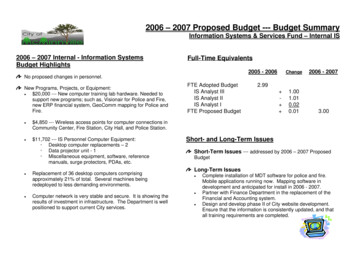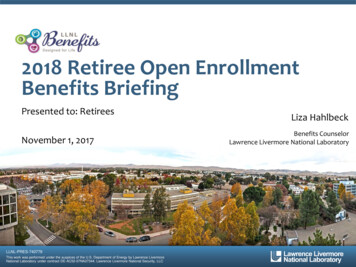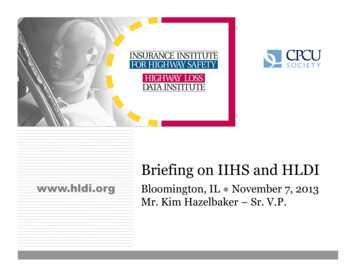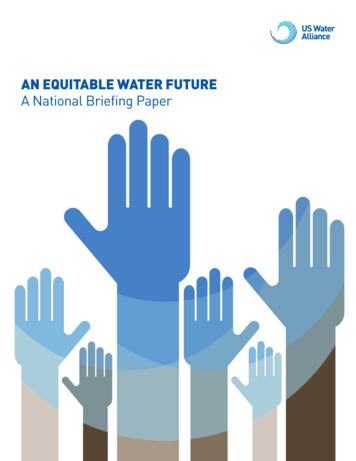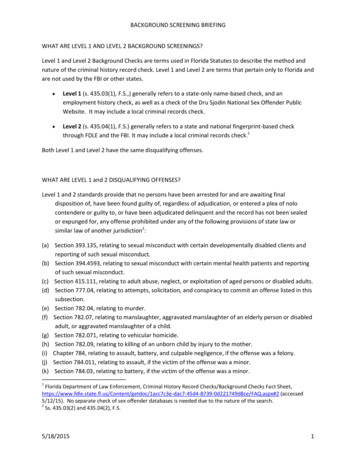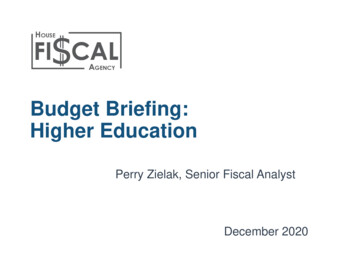
Transcription
Budget Briefing:Higher EducationPerry Zielak, Senior Fiscal AnalystDecember 2020
Briefing Topicso Funding Sourceso Appropriations Areaso Major Budget Topics Public University Data Continuing Challenges for Higher Education BudgetHouse Fiscal Agency2December 2020
Higher Education Budgeto Article VIII of the State Constitution addresses public universities: Section 4 requires legislature to appropriate funds to maintain Michigan’s15 public universities Section 5 provides for elected boards of control for the University ofMichigan, Michigan State, and Wayne State Section 6 provides for appointed boards of control for remaining universities Sections 5 and 6 grant each university board “the control and direction ofall expenditures from the institution’s funds”o Annual Higher Education budget: Provides operational funds to the 15 public universities Funds various financial aid programs Supports several other university-related costs Since FY 2011-12, has been enacted into compiled law as amendments tothe School Aid ActHouse Fiscal Agency3December 2020
Key Budget TermsFiscal Year: The state’s fiscal year (FY) runs from October to September. FY 202021 is October 1, 2020 through September 30, 2021.Appropriation: Authority to expend funds. An appropriation is not a mandate tospend. Constitutionally, state funds cannot be expended without an appropriation bythe legislature.Line Item: Specific appropriation amount that establishes spending authorizationfor a particular program or function in a budget bill.Boilerplate: Specific language sections in a budget bill that direct, limit, or restrictline item expenditures, express legislative intent, and/or require reports.Lapse: Appropriated amounts that are unspent or unobligated at the end of a fiscalyear. Appropriations are automatically terminated at the end of a fiscal year unlessdesignated as a multi-year work project under a statutory process. Lapsed fundsare available for expenditure in the subsequent fiscal year.Note: Unless otherwise indicated, historical budget figures in this presentation havenot been adjusted for inflation.House Fiscal Agency4December 2020
Funding SourcesHouse Fiscal Agency5December 2020
FY 2020-21 Higher Education BudgetFund SourceGross AppropriationsInterdepartmentalGrants (IDG) RevenueAdjusted GrossAppropriationsFederal RevenueFunding 1,699,925,4000 1,699,925,400DescriptionTotal spending authority from all revenue sourcesFunds received by one state department from another statedepartment, usually for services providedGross appropriations excluding IDGs; avoids double countingwhen adding appropriation amounts across budget areas126,026,400Federal grant or matching revenue; generally dedicated tospecific programs or purposesLocal Revenue0Revenue received from local units of government for stateservicesPrivate Revenue0Revenue from individuals and private entities, includingpayments for services, grants, and other contributionsState RestrictedRevenue356,063,300State revenue restricted by the State Constitution, statestatute, or outside restriction that is available only forspecified purposes; includes most fee revenueState GeneralFund/General Purpose(GF/GP) RevenueHouse Fiscal Agency 1,217,835,700Unrestricted revenue from taxes and other sources availableto fund basic state programs and other purposes determinedby the legislature6December 2020
FY 2020-21 Fund SourcesNearly three-fourths of the 1.7 billion Higher Education budget is funded with stateGeneral Fund/General Purpose money. All of the 356.1 million in restricted funding isSchool Aid Fund appropriations.State Restricted 356,063,30021%Federal 126,026,4007%State GF/GP 1,217,835,70072%House Fiscal Agency7December 2020
Higher Ed Share of Total State BudgetThe Higher Education budget represents about 3% of the 61.6 billion state budget(adjusted gross) for FY 2020-21.School Aid 15,525,164,80025%Transportation 5,103,407,5008%Corrections 2,060,788,4004%Higher Education 1,699,925,4003%Health and HumanServices 28,484,618,70046%Revenue Sharing 1,341,924,3002%Other Areas 5,723,058,9009%House Fiscal Agency8Labor and EconomicOpportunity 1,625,864,3003%December 2020
Higher Ed Share of Total GF/GP BudgetWhile only 3% of the total state budget, the Higher Education budget represents about12% of the state’s 10.6 billion GF/GP budget for FY 2020-21.Corrections 1,809,258,40017%Higher Education 1,217,835,70012%Health and HumanServices 5,090,371,10048%State Police 439,376,6004%Debt Service/SBA Rent 345,305,6003%Other Areas 1,558,953,40015%House Fiscal Agency9School Aid/ Dept ofEducation 141,031,7001%December 2020
FY 2020-21 School Aid Fund AppropriationsThe Higher Education budget receives about 2% of the 14.4 billion in FY 2020-21School Aid Fund appropriations.Community Colleges 425,667,6003%Higher Education 356,063,3002%School Aid 13,589,621,60095%House Fiscal Agency10December 2020
Higher Education Funding HistoryWhile Higher Education appropriations have grown fairly steadily since their 15-year lowin FY 2011-12, they are still about 10% below the 15-year peak of 1.9 billion in FY2007-08. FY 2007-08 also was the first year that the state started using federal TANFfunds to support financial aid programs. 2,000 1,800 1,600 1,400Millions 1,200 1,000 800 600 400 200 0FY2007FY2008FY2009FY2010FY2011FY2012GF/GPHouse Fiscal 2018FY2019FY2020FY2021FederalDecember 2020
Appropriation AreasHouse Fiscal Agency12December 2020
Higher Education Appropriation AreasThe Higher Education budget funds:o Operational grants for the state’s 15 public universities, consisting of separateappropriations for baseline funding (established from prior-year totals), FY 202021 performance funding increases, and North American Indian Tuition Waivercosts.o AgBioResearch and Extension programs at Michigan State University.o Financial aid programs for students attending public or private colleges oruniversities in Michigan.o Partial costs of university participation in MPSERS, the Michigan Public SchoolEmployees’ Retirement System. This also includes an offset to reimburseuniversities’ normal cost increase to reduce the assumed rate of return from7.05% to 6.8%.o Various smaller items related to higher education, such as the King-ChavezParks program and the state’s higher education database (HEIDI).House Fiscal Agency13December 2020
FY 2020-21 Gross AppropriationsOver 87% of the Higher Education budget goes to funding public university operations.Financial Aid 145,283,2008%MSU AgBioResearch &Extension 65,073,4004%MPSERS and NormalCost Offset 12,895,0001%Other 3,006,5000%University Operations 1,473,667,30087%House Fiscal Agency14December 2020
Major Budget TopicsHouse Fiscal Agency15December 2020
Michigan’s Public UniversitiesUniversityAbbreviationFoundedCentral Michigan UniversityCMU1892Eastern Michigan UniversityEMU1849Ferris State UniversityFSU1884Grand Valley State UniversityGVSU1960Lake Superior State UniversityLSSU1946Michigan State UniversityMSU1855Michigan Technological UniversityMTU1885Northern Michigan UniversityNMU1899Oakland UniversityOU1957Saginaw Valley State UniversitySVSU1963University of Michigan – Ann ArborUMAA1817University of Michigan – DearbornUMD1959University of Michigan – FlintUMF1956Wayne State UniversityWSU1868Western Michigan UniversityWMU1903House Fiscal Agency16December 2020
University Operations FundingThe Constitution does not specify how funding is to be distributed amonguniversities.The legislature annually appropriates funds for individual universities, a process thatin recent years has included the use of a performance funding formula to allocatethe total increase (or decrease) in state appropriations for university operations.Any increased funding for universities is distributed using the performance formula.The formula is specified in annual budget act language.Each university’s operations funding currently consists of three parts: Baseline funding, which is the total amount appropriated in the prior year. Performance funding, new appropriations determined through the formula. North American Indian Tuition Waiver costs, funding provided to universitiesto cover waived tuition costs for eligible students.House Fiscal Agency17December 2020
FY 2020-21 University Operations GrantsFunding for university operations varies widely, ranging from 15.3 million for LSSU to 322.9 million for UMAA. There were no performance funding increases for FY 202021. Indian Tuition Waiver funding ranges from 167,800 at UMD to 1.9 million forCMU. Total operations funding is 1.5 billion. 300 250 Millions 200 150 100 50 0LSSU UMFUMD SVSU NMUBaseline FundingHouse Fiscal AgencyMTUOUFSU GVSU EMUPerformance Funding18CMUWSU WMUMSU UMAAIndian Tuition Waiver FundingDecember 2020
University Operations Grants HistoryState support for public universities operations has increased by 266.4 million (22%)since FY 2011-12, but remains 92.3 million (6%) below the FY 2002-03 peak of 1.6billion. 1,600 1,400 1,200Millions 1,000 800 600 400 200 0GF/GPHouse Fiscal AgencySchool Aid Fund19December 2020
University Operations Grants perFiscal Year Equated Student (FYES)To account for varying enrollments, funding for university operations often is comparedon a per-student basis. The full-time equivalency (or Fiscal Year Equated Student)measurement for each student level is calculated by dividing the total credit hours in agiven year by the number of credits considered to be full-time (30 for undergraduates). 10,000 9,000 8,000FY 2021 funding per FY 2020 Fiscal Year EquatedStudent (includes undergraduates and graduates,resident and non-resident) 7,000 6,000 5,000 4,000 3,000 2,000 1,000 0House Fiscal Agency20December 2020
Historical University Appropriations perFiscal Year Equated Student (FYES)Using the most recently available FYES data, total FY 2020-21 appropriations per FYESof 5,749 are about 16% lower than FY 2000-01’s high of 6,841 per FYES.Appropriations per FYES are about 38% lower on an inflation-adjusted basis. 8,000 6,000 4,000NominalInflation-Adjusted 2,000 0FY FY FY FY FY FY FY FY FY FY FY FY FY FY FY FY FY FY FY FY FY2001 2002 2003 2004 2005 2006 2007 2008 2009 2010 2011 2012 2013 2014 2015 2016 2017 2018 2019 2020 2021FY 2019-20 appropriations per FYES calculated using FY 2018-19 FYES.House Fiscal Agency21December 2020
FY 2020-21 Performance FundingSince FY 2012-13, funding increases have been based on a performance funding model.The formula specifies the percentage of total performance funding that is distributedunder each of several metrics. The formula was suspended for FY 2020-21.% ofPerformanceFundingFY 2020-21 Formula ComponentFY 2020-21AmountProportional to each university’s share of total operations fundingin the baseline year of FY 2010-1150.0% 0Undergraduate degree completions in critical skills areas(generally STEM fields)11.1% 0Total R & D expenditures (applies to high-research universitiesonly)5.6% 0Comparisons with Carnegie Classification peers or 3-yearimprovement, scored on four metrics:33.3% 0100% 0 Six-year graduation rate Total degree completions Institutional support (i.e., administration) as a percentageof core expenditures Percentage of students receiving federal Pell grantsTotal Performance FundingHouse Fiscal Agency22December 2020
Performance Funding ConditionsReceipt of performance funding for the next 3 fiscal years is conditioned oncompliance with all of the following:o Restraining resident undergraduate tuition and mandatory fee increases to 4.2%or 586 (whichever is greater) over the prior year.o Certifying that the university participates in reverse transfer agreements with atleast three Michigan community colleges.o Certifying that the university’s dual enrollment policy does not consider whethercredits were used toward high school graduation.o Actively participating in the Michigan Transfer Network.House Fiscal Agency23December 2020
Tuition Restraint PoliciesBudget-based efforts to curb tuition increases have taken several forms since FY 2011-12.Under the budget act, performance funding forfeited by noncompliant universities is distributedto the other schools.FY 2015-16FY 2016-17Limit on residentundergraduatetuition/fee increases3.2%4.2%Operations fundingincrease/(decrease)from prior year1.5%2.9%Funding contingenton tuition restraint 20.1 millionperformancefunding 39.8 millionperformancefunding; newstate-fundedcapital outlayapprovals forFYs 2017-18and 2018-19Average unweightedtuition/fee eNoneNoneNoneNoneNoncompliantuniversitiesHouse Fiscal AgencyFY 2017-18FY 2018-19FY 2019-20FY 2020-213.8% or 475 3.8% or 490 4.4% or 587 4.2% or 5862.0%2.0%0.5%0.0% 28.0 million 28.6 million 7.9 millionFunding forperformance performance performancenext 3 FYs;funding; newfunding;funding;new statestate-fundedfunding forfunding for funded capitalcapital outlay next 3 FYs;next 3 FYs;outlayapprovals fornew statenew stateapprovals forFYs 2018-19 funded capital funded capital next 3 FYsand 2019-20outlayoutlayapprovals for approvals fornext 3 FYsnext 3 FYs24December 2020
Funding Conditions Based on Title IXRelated RequirementsContinued from the prior fiscal year, universities must certify compliance with arange of conditions related to Title IX and sexual assault prevention requirements.Failure to certify to the State Budget Office will result in a withholding of 10% ofOperations funding. Some conditions include:o Submission of the university’s annual Title IX Report and an accompanyingsummary report to the legislature.o Providing in-person sexual assault prevention training to all freshman andtransfer students, along with electronic training for all other students.o Having the president and governing board members review Title IX complaintsregarding university employees.o Having a third party review a university’s Title IX office and related policies, andsubmitting that review to the legislature.o Notifying someone who reports sexual assault of their options to report to lawenforcement and/or the university.o Prohibiting the issuance of divergent Title IX reports.House Fiscal Agency26December 2020
North American Indian Tuition Waiver (ITW)FY 2020-21 ITW appropriations were adjusted to match reported waiver costs forFY 2018-19. A separate ITW funding category is delineated in each university’sappropriation line item. 2,500 2,000 Thousands 1,500 1,000 500 0CMUEMUFSU GVSU LSSU MSUMTUNMUOUSVSU UMAA UMDUMFWSU WMUITW FundingHouse Fiscal Agency27December 2020
MSU AgBioResearch and ExtensionA total of 65.1 million GF/GP is appropriated to Michigan State University to operatetwo statewide programs, AgBioResearch and Extension.o MSU AgBioResearch: 34.9 million Agriculture research program conducted in on-campus laboratories and at 13research centers across the state.o MSU Extension: 30.1 million Program jointly funded with counties to extend MSU’s public service missionacross the state in various program areas: Agriculture Business and Community Family Food and Health Lawn and Garden Natural Resources 4-H and YouthMSU receives additional funding for these programs from federal, private, and localsources.House Fiscal Agency28December 2020
Grants and Financial AidTotal Appropriation: 145.3 milliono Tuition Incentive Program ( 68.8 million)Associate’s degree tuition for Medicaid-eligible students completing high school, andtuition assistance of up to 2,000 for participants continuing on with a baccalaureate.o Tuition Grant Program ( 42.0 million)Need-based awards to students attending independent colleges. FY 2020-21 awardsof 2,800, with total awards at individual universities capped at 4.8 million each.o State Competitive Scholarships ( 29.9 million)Awards to students with qualifying ACT or SAT score and financial need; 1,000award in FY 2020-21. (Use of SAT commenced with graduating class of 2017; ACTcontinues in use for prior classes.)o Project GEAR UP ( 3.2 million)Federally funded awards targeted to students in urban school districts.o Children of Veterans and Officer’s Survivor Tuition Grant Programs ( 1.4million)Grants to children of deceased or disabled veterans and children of police officersand firefighters killed in the line of duty.House Fiscal Agency29December 2020
FY 2020-21 Financial Aid AppropriationsAlmost half of the 145.3 million appropriated for grants and financial aid goes to theTuition Incentive Program.State CompetitiveScholarships 29,861,70021%Tuition Grants 42,021,50029%Project GEAR UP 3,200,0002%Veterans'Children/Officers'Survivors 1,400,0001%Tuition IncentiveProgram 68,800,00047%House Fiscal Agency30December 2020
Financial Aid Fund SourcesFederal Temporary Assistance for Needy Families (TANF) appropriations providethe majority of funding for the three major state financial aid programs.ProgramFederalRestrictedGF/GPTotalTuition Incentive Program 68,800,000 0 0 68,800,000Tuition Grants 30,095,600 0 11,925,900 42,021,500State CompetitiveScholarships 23,930,800 0 5,930,900 29,861,700Project GEAR UP 3,200,000 0 0 3,200,000 0 0 1,400,000 1,400,000 126,026,400 0 19,256,800 145,283,200Veterans’ Children/Officers’ SurvivorsTOTALSHouse Fiscal Agency31December 2020
Need-Based and Merit-Based StateFinancial Aid ProgramsFunding for merit-based programs was virtually eliminated in FY 2009-10; the onlyremaining merit-based program is the 1.4 million program for veterans’ children andofficers’ survivors. Funding for need-based programs is at a peak of 143.9 million forFY 2020-21. 300 250 Millions 200 150 100 50 0FY FY FY FY FY FY FY FY FY FY FY FY FY FY FY FY FY FY FY FY2002 2003 2004 2005 2006 2007 2008 2009 2010 2011 2012 2013 2014 2015 2016 2017 2018 2019 2020 2021Need-BasedHouse Fiscal Agency32Merit-BasedDecember 2020
Tuition Incentive Program (TIP)o Established in FY 1986-87 as incentive for low-income students to complete high schooland enroll in college. To participate, the student must be Medicaid-eligible for 24 monthswithin a consecutive 36-month period prior to high school completion.o Program has two phases: Phase I: Associate’s degree tuition costs (at private institutions, limited to averagepublic community college tuition) Phase II: Up to 2,000 total toward completion of a bachelor’s degreeo Large potential pool of applicants: Department of Treasury sends about 280,000 letters toeligible students each year. FY 2020-21 removed the application process, although eligiblestudents must still complete the FAFSA.o Over 80% of the 15,394 Phase I students in FY 2018-19 were enrolled at communitycolleges. Number of students claiming Phase II awards was much smaller, at 8,855.o Due to Medicaid caseload growth, increasing participation rates, and, more recently,increases in tuition costs, program costs have increased from 5.0 million in FY 2000-01 toabout 52.0 million in FY 2018-19.House Fiscal Agency33December 2020
TIP Participation and AppropriationsAfter years of relatively level growth, TIP participation has seen a recent increase.Program appropriations have continued to grow, although at a slightly slower rate inrecent years before recent appropriation increases over the last two fiscal years.30,000 80 7025,000 6020,00015,000 40StudentsPayments MillionsStudents 50 3010,000 205,000 100 0FY FY FY FY FY FY FY FY FY FY FY FY FY FY FY FY FY2005 2006 2007 2008 2009 2010 2011 2012 2013 2014 2015 2016 2017 2018 2019 2020 2021Approp.House Fiscal Agency34December 2020
Other State-Funded Programso MPSERS UAAL State Share Payments: 11.7 million SAF Funds the difference between a statutory cap on university payments into MPSERS and auniversity’s unfunded actuarial accrued liability. Cap of 25.73% of applicable payroll wasenacted by 2016 PA 136. Affects the seven universities with MPSERS employees: CMU,EMU, FSU, LSSU, MTU, NMU, WMU. Em
Michigan Technological University MTU 1885 Northern Michigan University NMU 1899 . The full-time equivalency (or Fiscal Year Equated Student) . o Certifying that the university participates in reverse transfer agreemen

